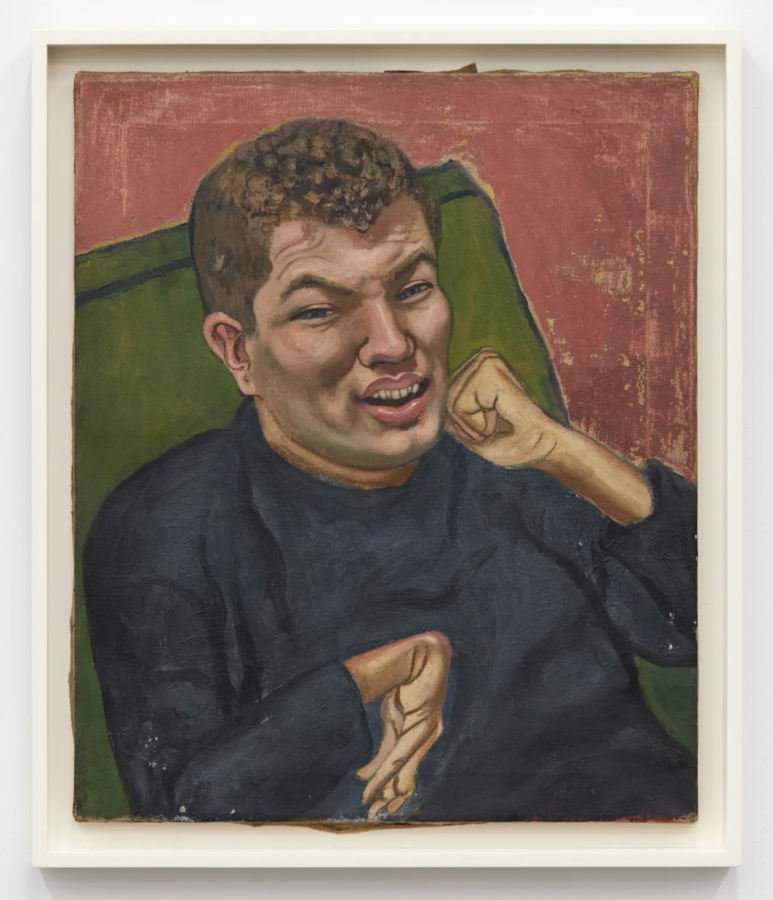September 2021
Download as PDF
View on TheGuide.Art

Alice Neel, Steven Dunn, ND. Oil on canvas, 27 × 22¾ inches.
I saw “Get Lifted!” at Karma as soon as Tropical Storm Henri had also lifted—though not before drenching New York City for the better part of a late summer weekend after making a splashy debut on Saturday night, when it unleashed the rainiest single hour ever recorded within the five boroughs. In its aftermath, bulbous droplets were falling from scaffoldings as clouds made way for the long-hidden sun. A post-storm serenity permeated the air. The atmosphere within this Hilton Als-curated group exhibition seems to share this sensibility—and understandably so: it being an exploration of physical and spiritual rejuvenation after loss.
The poetic softness inherent in Als’s prose becomes almost tangible across works produced over the past 100-some years by more than thirty artists, including Peter Hujar, Diane Arbus, Jack Whitten, Glenn Ligon, Alice Neel, Somaya Critchlow, Lee Friedlander, and Ana Mendieta. Through this selection, the author and longtime New Yorker critic considers human nature in terms of essential survival instincts. Als expounds on his thesis through five texts that ponder how art, across civilizations, has served as a guiding light. Among his contextual touchstones are the wars and calamities of the 20th century as well as the ongoing crises of our current era, from the pandemic to the fight for racial justice.
Introducing the presentation is a linear, flowing arrangement of mid-size wall-works that encapsulate the passage of time and its healing power. In the left-most slot resides the late Antiguan artist Frank Walter’s untitled and undated painting of a Black boy joyfully swimming in turquoise waters. A similarly infinite blue expanse can be found in Paul Thek’s Untitled (FIREFLY) (1977), an ink-on-paper sketch that evokes a nocturnal landscape. Nearby, in another nameless and date-less composition by Walter, a Black woman, dressed in a fiery red shirt and hat, stands on a rectangular carpet in the same crimson hue; she’s smiling broadly, her gaze resting squarely on the viewer. Behind her, an expansive, verdant field recedes toward a thicket of trees that, with lush, green foliage, rise up from the horizon and eclipse the sky. Between the overt use of contrasting colors and the subject’s enigmatic countenance, the composition generates a compelling, mysterious energy. It intrigued me enough to further investigate Walter’s biography: The artist, a Caribbean native who passed away in 2009 at the age of 82, was also a photographer, philosopher, a prolific writer, and a poet who, from middle age on, lived in seclusion to focus on these manifold creative pursuits.
The full scope of Als’s selections likewise goes beyond painting—other mediums on view range from photography and video to archival ephemera. Exemplifying the latter is a collection of vintage snapshots and manuscript pages assembled to commemorate the late playwright Ntozake Shange and the circa 1976-77 theatrical production of her widely acclaimed masterpiece, For Colored Girls Who Have Considered Suicide When the Rainbow Is Enuf. Elsewhere, take care to spend time with Stacy Lynn Waddell’s Untitled (Three Friends Smiling and Striking a Pose) (2021), a large-scale, 22-karat gold leaf-on-canvas composition, wherein an image of three friends is concealed beneath the material’s oscillating shimmer. The moment of discovery as your body moves around the painting, however, proves rewarding.
Paul Pfeiffer’s looping video, Live Evil (Kuala Lumpur) (2003), hides in the backroom, doing the moving itself. In a separate body of work, Pfeiffer culled clips from sports games to assemble frenetic, pop culture-driven digital montages. Here, the artist manipulated footage of Michael Jackson dancing on stage, effectively wielding the singer’s image to reflect on its power and weakness. What results is Michael Jackson, still—but, now, with the figure bisected and rearranged into symmetrical halves and sped up to a delirium-inducing pace, his form looks to be a mere smear of movement. First impressions? A shaman in a moment of ecstasy, perhaps, or a ghost haunting a house. Yet, once any remotely pop culture-acquainted onlooker becomes clued in upon noticing, say, gold light glinting off a glittering jacket or bits of familiar choreography, recognition is instantaneous. What makes him Michael Jackson is his dancing—and if that’s preserved, it can render the iconic persona legible even as the person is obscured.
Meanwhile, in this reality, life was creeping back to normal after the deluge of environmental mishaps—climate change’s game, set, and match to urban hedonists. “Get Lifted!” offers evidence that we, as humans, can endure: because we can craft our way out of darkness. To wit, the gallery’s staff had strategically placed three buckets—elegant ones—throughout the space to collect leaking droplets.



